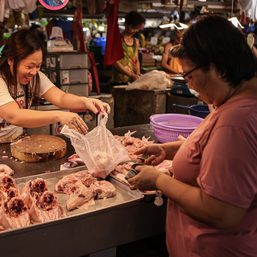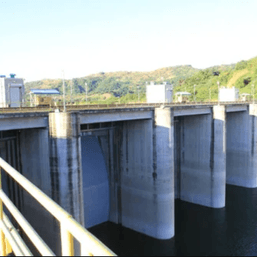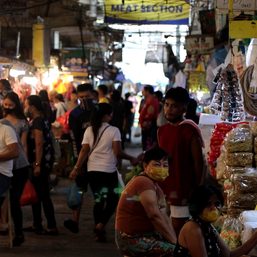SUMMARY
This is AI generated summarization, which may have errors. For context, always refer to the full article.
![[In This Economy] Runaway rice prices are making inflation higher than it needs to be](https://www.rappler.com/tachyon/2024/02/tl-rice-prices.jpg)
It’s hard to overstate how much inflation has gone down since last year.
In January 2023, inflation reached a fever pitch of 8.7%, the highest in 14 years. But by January 2024, inflation has gone down to 2.8% (Figure 1).
Sure, that doesn’t mean that prices on average are going down. But at least prices have slowed down a lot. And 2.8% inflation is well within the government’s target range of 2-4%.
Figure 1.
Figure 2 shows that, just like in previous months, food inflation in January accounted for nearly half of overall inflation. But food inflation is also the main reason for the similarly rapid decline of overall inflation. Some foodstuffs are, in fact, getting cheaper.
Figure 2.
Digging even deeper, Figure 3 shows that January 2024 is the third straight month when vegetables actually experienced deflation or declining prices.
Note, however, that there’s one component contributing more and more to food inflation: rice. What this tells us is that overall inflation, low as it already is, could in fact be even lower if only rice prices aren’t accelerating.
Figure 3.
Just how high are rice prices now?
Figure 4 shows that as of January 2024, regular-milled rice is averaging P49.65 per kilo. That’s 25.3% higher than last year, and almost 2.5times the promised rice price of President Ferdinand Marcos Jr. when he was running for president.
Meanwhile, well-milled and special rice in January 2024 are at P54.91 and P63.9 per kilo, respectively. This means a 25% and 18.7% inflation, respectively, too, over the past year.
Figure 4.
Managing rice prices
Why are rice prices accelerating? To be honest, we should have seen this a mile away.
Last November 8, I wrote: “Even if inflation went down in October, it can still spike in the coming months, notably due to the El Niño season, which could hamper agricultural (especially rice) production.”
Thanks to deflating vegetable and electricity prices, overall inflation isn’t exactly spiking now. But I was right that El Niño could spell higher rice prices, and now that is precisely the culprit keeping inflation higher than it needs to be.
On February 9, Agriculture Secretary Francisco Tiu Laurel Jr. admitted that rice prices might remain elevated until September owing to El Niño and elevated world rice prices.
Rising prices might suggest that demand may be outstripping supply. So we must naturally ask: Will there be enough rice in the Philippines in the coming months?
Secretary Tiu Laurel Jr. made assurances that we don’t have to worry, at least in the first half of 2024. Even with challenges to domestic production, we will still be able to import rice.
In fact, the US Department of Agriculture increased its forecast of rice imports in the Philippines, up to 3.8 million metric tons of rice.
Thanks are due Vietnam, which, in a show of regional solidarity, recently committed to export to the Philippines anywhere from 1.5 to 2 million metric tons of rice a year, for the next five years.
Of course, many wonder if the Philippines will ever be rice self-sufficient. The Marcos administration is currently aiming for 97.4% rice self-sufficiency by 2028. That means that nearly all of the country’s rice supply must come from local sources.
But I think this will still be a pipe dream, given our peculiar geography and other circumstances. (Interestingly, rice self-sufficiency was also promised by Ferdinand E. Marcos, during the Martial Law era, to no avail.)
As domestic rice prices continue to climb, the last thing we want is a repeat of the inept and frankly stupid rice price ceilings imposed by the Marcos administration last September. As I wrote before, that policy is a perfect illustration of why the path to hell is often paved with good intentions.
Sans rice, is inflation…too low?
Suppose we live in a parallel universe where, holding all else equal, rice prices were better managed. This means that inflation in January 2024 could, in fact, be much lower than 2.8%, maybe 2% or even lower.
That, in itself, may pose problems, too.
Targeting inflation is like aiming for a Goldilocks zone: inflation must not be too hot nor cold. It should be just right.
If inflation is too low, that could mean that the economy is producing under capacity: given our resources, we could be producing more goods and services, but just aren’t.
Sure, the unemployment rate was just at 3.1% in December 2023, the lowest since the earliest comparable data in 2005 or almost two decades ago. Some might take it to mean that human resources are being used to the brim (technically this might be called a “tight labor market”).
But analysts caution that this may be illusory, as evidenced by the still high underemployment rate. And they would be correct. More than a tenth of all employed Filipinos are still looking to work more hours or get additional jobs just to get by.
Another interpretation is that the interest rate hikes of the Bangko Sentral ng Pilipinas (BSP), designed to slow down inflation, may be working a little too effectively. That is, too many individuals and businesses are postponing borrowing and, consequently, putting off investments and other activities that could otherwise boost the economy.
In my column last week, I showed data that in 2023, the contribution of investments to overall growth more than halved.
Believing that interest rates are indeed choking off investments, many analysts are eagerly expecting interest rates to go down again soon.
But I’m guessing that the BSP won’t let interest rates go down too much, given threats to inflation in the near term (like El Niño). If ever there will be a drop in interest rates, it will be but small – just to test the waters, so to speak.
You see, even if we made significant strides in controlling inflation in the past year, the last thing the BSP wants now is a new spike in inflation that might set off yet another episode of high inflation, in a sort of self-fulfilling prophecy.
The next BSP Monetary Board meeting is scheduled on Thursday, February 15. Let’s see how the Board makes up its mind this time around. – Rappler.com
JC Punongbayan, PhD is an assistant professor at the UP School of Economics and the author of False Nostalgia: The Marcos “Golden Age” Myths and How to Debunk Them. JC’s views are independent of his affiliations. Follow him on Twitter (@jcpunongbayan) and Usapang Econ Podcast.
1 comment
How does this make you feel?
![[In This Economy] Marcos’ POGO ban is popular, but will it work?](https://www.rappler.com/tachyon/2024/07/thought-leaders-marcos-pogo-ban.jpg?resize=257%2C257&crop=255px%2C0px%2C720px%2C720px)
![[Rappler Investigates] POGOs no-go as Typhoon Carina exits](https://www.rappler.com/tachyon/2024/07/newsletter-graphics-carina-pogo.jpg?resize=257%2C257&crop=424px%2C0px%2C1080px%2C1080px)





![[Just Saying] SONA 2024: Some disturbing points](https://www.rappler.com/tachyon/2024/07/TL-marcos-sona-points-july-23-2024.jpg?resize=257%2C257&crop=335px%2C0px%2C720px%2C720px)

![[EDITORIAL] Apat na taon na lang Ginoong Marcos, ‘di na puwede ang papetiks-petiks](https://www.rappler.com/tachyon/2024/07/animated-bongbong-marcos-2024-sona-day-carousel.jpg?resize=257%2C257&crop=280px%2C0px%2C720px%2C720px)
![[In This Economy] Delulunomics: Kailan magiging upper-middle income country ang Pilipinas?](https://www.rappler.com/tachyon/2024/07/in-this-economy-upper-middle-income-country.jpg?resize=257%2C257&crop=421px%2C0px%2C1080px%2C1080px)

![[EDITORIAL] Marcos Year 2: Hilong-talilong](https://www.rappler.com/tachyon/2024/07/animated-bongbong-marcos-2nd-sona-carousel.jpg?resize=257%2C257&crop=136px%2C0px%2C720px%2C720px)
![[Newspoint] A fighting presence](https://www.rappler.com/tachyon/2024/07/thought-leaders-a-fighting-presence.jpg?resize=257%2C257&crop=441px%2C0px%2C1080px%2C1080px)




![[In This Economy] Peso approaches P60 per dollar once more. So what?](https://www.rappler.com/tachyon/2024/05/TL-peso-dollar-economy-may-24-2024.jpg?resize=257%2C257&crop=302px%2C0px%2C720px%2C720px)
![[Vantage Point] When sugar turns sour: End users agonize from high prices](https://www.rappler.com/tachyon/2024/02/tl-sugar-turns-sour-February-6-2024.jpg?resize=257%2C257&crop_strategy=attention)
![[OPINION] The politics of rice – and managing perception](https://www.rappler.com/tachyon/2023/09/politics-rice-september-14-2023.jpg?resize=257%2C257&crop_strategy=attention)


Hopefully, this will not happen: “… even if we made significant strides in controlling inflation in the past year, the last thing the BSP wants now is a new spike in inflation that might set off yet another episode of high inflation.” Thanks to Prof. JC Punongbayan for this update.